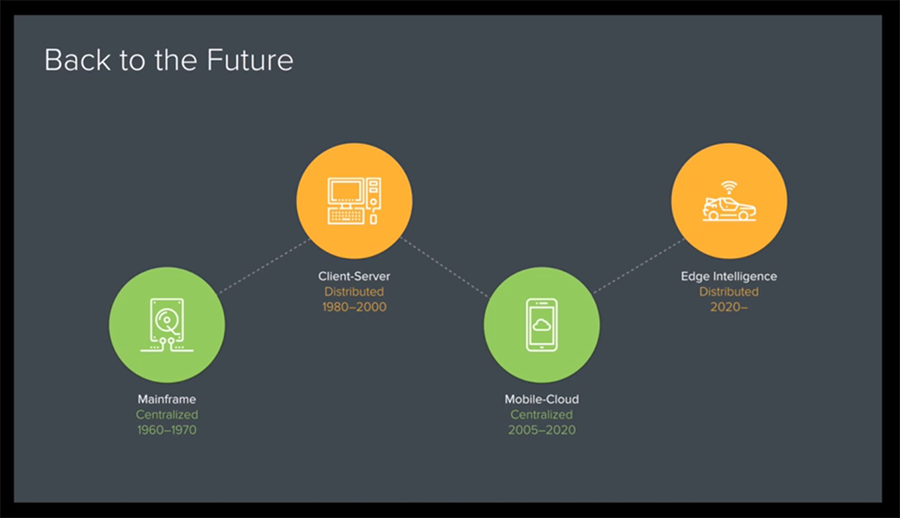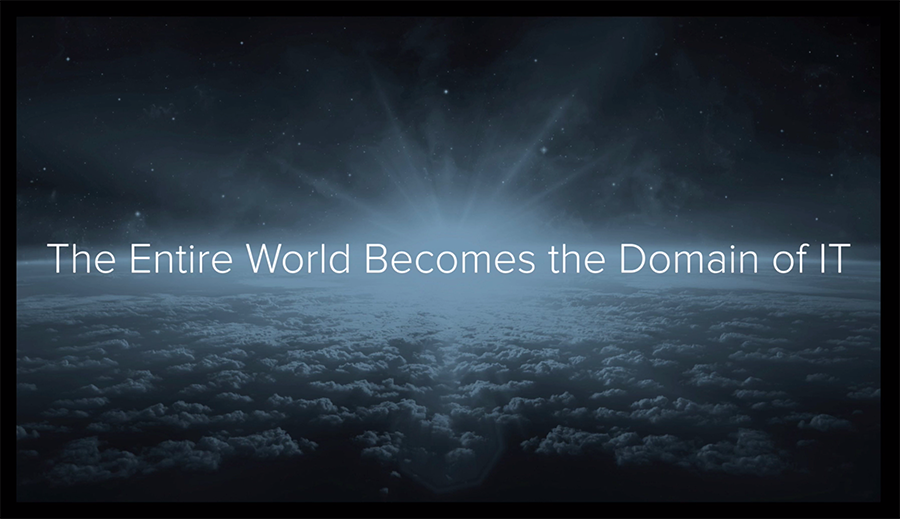The End of Cloud Computing, is a prophetic presentation by Peter Levine, of Andreesen Horowitz, and required viewing by anyone interested in making the distributed future happen.
His key point: “We are returning to an edge-intelligence distributed computing model that’s absolutely thematic with the trends in computing moving from centralized out to distributed,” which he illustrates this way:

Later he adds, “We are absolutely going to return to a peer-to-peer computing model where the edge devices connect together creating a network of end point devices not unlike what we sort of saw in the original distributed computing model.” Here’s a graphic for that one:

I added the face in the middle, because the edge is individuals and not just the technology and data occupying their lives.
Joe Andrieu wrote about this a decade ago in his landmark post VRM: The user as point of integration. An excerpt:
User Centrism as System Architecture
Doc Searls shared a story about his experience getting medical care while at Harvard recently. As a fellow at the Berkman center, he just gave them his Harvard ID card and was immediately ushered into a doctor’s office–minimal paperwork, maximal service. They even called him a cab to go to Mass General and gave him a voucher for the ride. At the hospital, they needed a bit more paperwork, but as everything was in order, they immediately fixed him up. It was excellent service.
But what Doc noticed was that at every point where some sort of paperwork was done, there were errors. His name was spelled wrong. They got the wrong birthdate. Wrong employer. Something. As he shuffled from Berkman to the clinic to the cabbie to the hospital to the pharmacy, a paper (and digital trail) followed him through archaic legacy systems with errors accumulating as he went. What became immediately clear to Doc was that for the files at the clinic, the voucher, the systems at the hospital, for all of these systems, he was the natural point of data integration… he was the only component gauranteed to contact each of these service providers. And yet, his physical person was essentially incidental to the entire data trail being created on his behalf.
User as Point of Integration
But what if those systems were replaced with a VRM approach? What if instead of individual, isolated IT departments and infrastructure, Doc, the user was the integrating agent in the system? That would not only assure that Doc had control over the propagation of his medical history, it would assure all of the service providers in the loop that, in fact, they had access to all of Doc’s medical history. All of his medications. All of his allergies. All of his past surgeries or treatments. His (potentially apocryphal) visits to new age homeopathic healers. His chiropractic treatments. His crazy new diet. All of these things could affect the judgment of the medical professionals charged with his care. And yet, trying to integrate all of those systems from the top down is not only a nightmare, it is a nightmare that apparently continues to fail despite massive federal efforts to re-invent medical care.
(See The Emergence of National Electronic Health Record Architectures in the United States and Australia: Models, Costs, and Questions and Difficulties Implementing an Electronic Medical Record for Diverse Healthcare Service Providers for excellent reviews of what is going on this area, both pro and con.)
Profoundly Different
Doc’s insight–and that of user-centric systems–isn’t new. What’s new is the possibility to utilize the user-centric Identity meta-system to securely and efficiently provide seamless access to user-managed data stores. With that critical piece coming into place, we have the opportunity to completely re-think what it means to build out our IT infrastructure.
Which brings us to Peter Levine’s final point, and slide:

That world will be comprised of individuals operating with full agency, rather than as peripheral entities, and concerns, of centralized systems. Which is exactly what we’ve been fostering here at ProjectVRM from the start, ten years ago.
To obtain full agency, with control over the data and machine power suffusing our connected lives, we will need what’s been called first person or self-sovereign technologies. Not “personal power as a service” from some centralized system.
One immediate example is Adrian Gropper‘s Free Independent Health Records, which he’ll talk about on Thursday, January 26, at the Berkman Klein Center at Harvard University. At that link: “Gropper’s research centers on self-sovereign technology for management of personal information both in control of the individual and as hosted or curated by others.”
For other efforts in the same direction, see our VRM Development Work page.
Save
Save
